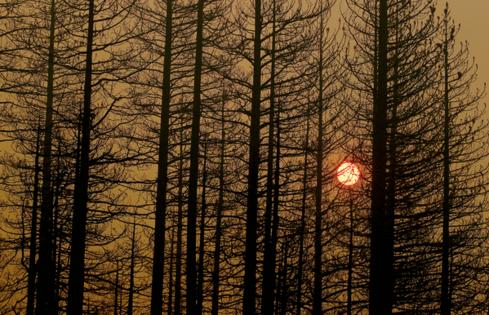Climate change supercharged a heat dome, intensifying 2021 fire season, study finds
Published in News & Features
As a massive heat dome lingered over the Pacific Northwest three years ago, swaths of North America simmered— and then burned. Wildfires charred more than 18.5 million acres across the continent, with the most land burned in Canada and California.
A new study has revealed the extent to which human-caused climate change intensified the extraordinary event, with researchers theorizing the heat dome was 34% larger and lasted nearly 60% longer than it would have in the absence of global warming. The heat dome, in turn, was associated with up to a third of the area burned in North America that year, according to the study, published in Communications Earth & Environment.
“What happens is you get a stagnated weather pattern — it’s very hot and very dry,” said study author Piyush Jain, research scientist with Natural Resources Canada. “And it dries out all the vegetation and makes whatever is on the ground extremely flammable.”
The study adds to a body of literature documenting how the fingerprints of climate change can be detected in events such as heat waves, droughts and wildfires.
Jain was living in Edmonton in late June 2021 when the mercury in North America’s northernmost million-resident city topped 100 degrees. “I was blown away,” he said. “I’d never experienced those temperatures anywhere I’d lived.”
Farther south, the town of Lytton, British Columbia, on June 29 experienced Canada’s hottest recorded temperature, 119 degrees, and was largely destroyed by a wildfire the next day.
The heat dome persisted for a staggering 27 days, from June 18 to July 14, with skyrocketing temperatures across the western United States and Canada killing hundreds of people, resulting in mass die-offs of marine life, devastating crop and timber yields and damaging infrastructure, buckling highways in Washington and melting train power lines in Portland. Over a five-day period in June, locations in seven U.S. states, including California, surpassed all-time maximum temperature records, according to the National Oceanic and Atmospheric Administration.
The heat wave also ratcheted up fire danger, breaking a slew of fire weather records over a broad area and helping to stoke blazes in British Columbia, California, Arizona, Colorado, Utah and Montana. More than 7.9 million acres burned in North America in July alone — at that time, the greatest area in a single month since record-keeping began, according to the study. Smoke traveled across the continent, triggering air quality alerts across much of the East Coast.
Jain had previously worked with other researchers to develop a method for evaluating such extreme weather events by looking at anomalies in geopotential heights, which indicate whether there are high or low pressure systems in the upper atmosphere. High pressure systems that persist for a long time tend to correspond with heat waves and increased fire risk, he said. And climate change has contributed to a trend of rising heights, potentially magnifying these events.
In this study, Jain and his colleagues analyzed what the heat dome would have looked like without this trend. They estimated that it would have been 34% smaller, 59% shorter and had a 6% lower magnitude.
...continued
©2024 Los Angeles Times. Visit at latimes.com. Distributed by Tribune Content Agency, LLC.







Comments